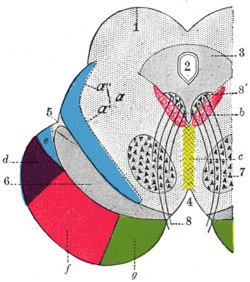Prätektales Syndrom
Das Prätektale Syndrom ist ein durch eine Schädigung prätektaler Strukturen entstehendes Krankheitsbild. Hauptsächlich geschädigt sind der rostrale Nucleus interstitialis (an der Formatio reticularis) des Fasciculus longitudinalis medialis (riRLF) und der Nucleus interstitialis CAJAL.
Hauptsymptome sind:[1]
- supranukleäre vertikale Blicklähmung
- fehlende Konvergenzreaktion der Augen
- Nystagmus
insgesamt dem Parinaud-Syndrom ähnlich.

Die Bezeichnung wurde von den Autoren einer Erstbeschreibung aus dem Jahre 1969 bei Affen vorgeschlagen,[2] das Syndrom beim Menschen im Jahre 1976 beschrieben.[3]
Der Begriff ist als rein klinische Beschreibung unspezifisch und wenig gebräuchlich.
Literatur
- J. R. Keane: The pretectal syndrome: 206 patients. In: Neurology. Bd. 40, Nr. 4, April 1990, S. 684–690, PMID 2320246.
Einzelnachweise
- ↑ J. Porta-Etessam, R. García-Ramos, J. Ruiz-Giménez, T. Moreno, J. Ruiz-Morales: Pretectal syndrome caused by multiple sclerosis. In: Journal of Neurology and Neuroscience. Bd. 1, Nr. 2, 2010, S. 1, doi:10.3823/305 (PDF).
- ↑ P. Pasik, T. Pasik, M. B. Bender: The pretectal syndrome in monkeys. I. Disturbances of gaze and body posture. In: Brain : a journal of neurology. Bd. 92, Nr. 3, 1969, S. 521–534, PMID 4979847.
- ↑ J. R. Keane, R. L. Davis: Pretectal syndrome with metastatic malignant melanoma to the posterior commissure. In: American journal of ophthalmology. Bd. 82, Nr. 6, Dezember 1976, S. 910–914, PMID 998705, doi:10.1016/0002-9394(76)90069-6.
Auf dieser Seite verwendete Medien
Axial section through mid-brain. (Schematic.) (Testut.) 1. Corpora quadrigemina. 2. Cerebral aqueduct. 3. Central gray stratum. 4. Interpeduncular space. 5. Sulcus lateralis. 6. Substantia nigra. 7. Red nucleus of tegmentum. 8. Oculomotor nerve, with 8’, its nucleus of origin. a. Lemniscus (in blue) with a’ the medial lemniscus and a" the lateral lemniscus. b. Medial longitudinal fasciculus. c. Raphé. d. Temporopontine fibers. e. Portion of medial lemniscus, which runs to the lentiform nucleus and insula. f. Cerebrospinal fibers. g. Frontopontine fibers.
